Vienna Ensemble Pro 7
Price: €195 ($217); upgrade(s) from Vienna Ensemble Pro 4, 5, 6: €45 ($50)
Buy online or from a local distributor.
Reviews here on MyMac of products from market leaders in music sample libraries and software, Vienna Symphonic Library (VSL), have consistently been positive:
Vienna Ensemble Pro (VEP) is the industry standard audio and music mixing/hosting application. Most serious musicians, composers, audio enthusiasts, technicians and directors make use of resources (virtual instruments (VIs), effects plug-ins, sequencers, Digital Audio Workstations (DAWs), notation packages, and input devices such as MIDI hardware etc) from more than one manufacturer and of more than type.
A typical workflow as sponsored by VEP would mix all such integrated resources in stereo and surround (up to 7.1) with equalizing, effects, panning, reverb and so on. If using a DAW like Apple’s Logic Pro X or notation software like Steinberg’s Dorico 2, Vienna Ensemble Pro will couple external resources to them and enable their configuration and manipulation for use directly inside those other apps… like Logic Pro X or Dorico.
Linking all of this together can be a complex and potentially error-prone task. VEP provides sophisticated and comprehensive control over such audio/music (re)sources and devices when working on a single computer. Indeed, the software supports most third-party VST/AU virtual instruments and effects plug-ins as well as VSL’s own sample player, Vienna Instruments Pro.
But VEP also works in a client-server mode enabling networked computer(s) to connect those same ranges of software and devices together using Ethernet – and so without (extra) MIDI or audio interfaces. It supports a single set of controls and one easy-to-read, visually clean and clear, user interface.
For a closer look at what VEP does, please see our review of VEP6 from September 2016.
Now, two and a half years later, VSL has released an update, Vienna Ensemble Pro 7 (VEP7). The experts at VSL have streamlined many processes, added many features and squashed many bugs – significantly to improve the user experience.
It should be said at the start of this evaluative review that Vienna Ensemble Pro 7 does its job extremely well… during the review period no failures, bugs or obstacles were encountered. Nor were there latency, lags or other shortcomings in performance.
The interface is indeed easier to use in VEP7 than in previous versions. When you need a preference or need to change a configuration, it is to be found in the obvious place. Those less often needed do not intrude. In practice, this works well.
If new to Vienna Ensemble Pro, you will want to use one or more of the resources provided by VSL to introduce you to the software’s conceptual basis so as to get to grips with how this is translated into actual workflows. If familiar with VEP6 or VEP5, the learning curve will be much less steep. These resources include video tutorials, active support forums, and a user manual.
Documentation
This documentation is a 139-page, 12.7 MB pdf. It takes you through every step of usage: downloading; installation; possible snags in the latter which may arise from network configuration and firewalls etc; the use of the Vienna Key and eLicenser Control Center hard- and software protection systems; typical setups and workflow environments. The manual has a glossary and directions for obtaining support. You’ll have to rely on the document’s table of contents, though, as there’s no index.
What’s New
The new features of Vienna Ensemble Pro 7 can be grouped into improvements and innovations in the interface itself, with plug-ins, and to streamline your workflow.
At heart, the designers and developers at VSL have concentrated on building on the advances and success of earlier versions. Greater use of dragging and dropping objects has been made in VEP7: from adjusting time or pitch parameters to placing plug-ins into racks and tracks – and much more. VEP7 stands out for the intelligent use it makes of the visual to represent the… “invisible†(that is: audio devices, channels, plug-ins and so on). Once you have understood the conceptual model employed by the designers at VSL and spent some time working and experimenting with VEP7, you’re very likely to find the mass of options and controls less intimidating than they at first appear. But do be prepared for that initial period of familiarization.
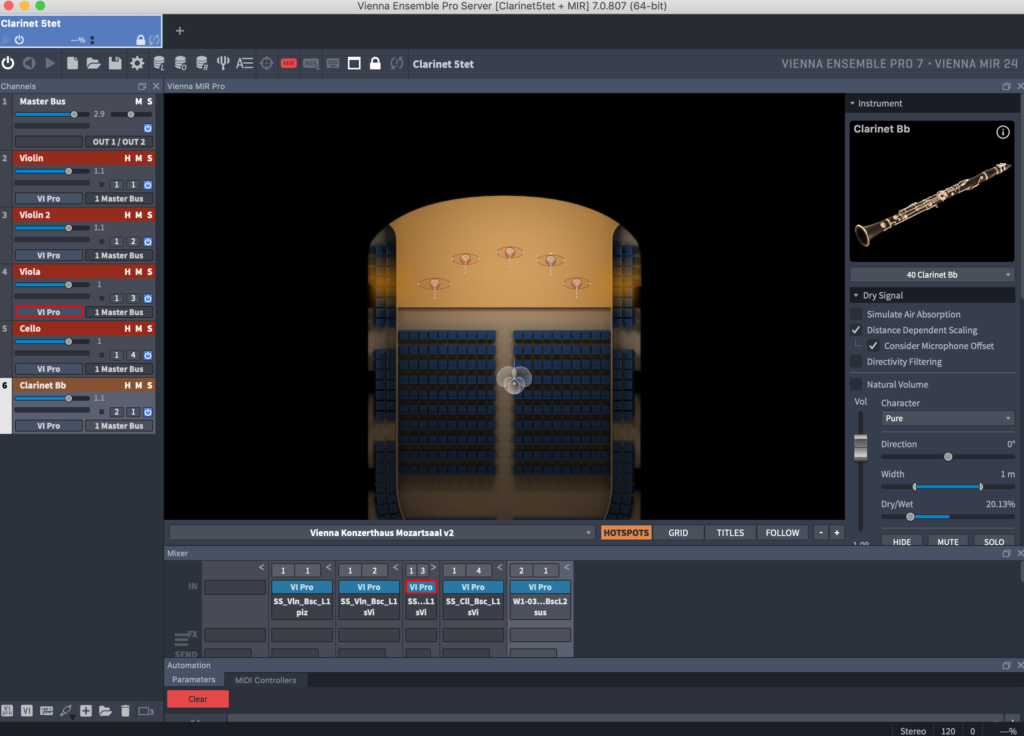
Interface
Actively understanding a complex piece of software with its many parameters (musical and technical) can be overwhelming. So anything and everything which the designers and developers can do to put you in control is welcome. Now, VEP7 provides useful and enhanced feedback and realtime displays of what’s going on at any given moment with all MIDI and audio activity and performance; as well as the CPU load taken by each Instance.
An “Instance†can be thought of as an aggregation of the settings, configurations, parameters, channel assignments and so on. Many Instances are possible. A “profile†if you like. Because of the conceptual framework underlying VEP you should also think of Instances as “objects†to be manipulated in order to control visually everything about the chain of audio devices and other software through to performance, notation or when monitoring output. Separate Instances might be employed for each of the different families of musical instruments in use for a project, for example… strings, woodwind, brass and so on.
You might also use one Instance for Logic, which uses one or more reverb configuration with VSL’s MIR Pro and a variety of FX plug-ins – and so which pays particular attention to the spacial element. Then another separate Instance for Dorico, Sibelius or Finale which is directed exclusively to expression maps so as to reproduce instruments’ articulations as they will end up on a printed score and so where the actual sound reproduced is not so important. Being able easily and swiftly to manage these Instances is crucial. VEP7 makes this process very easy indeed.
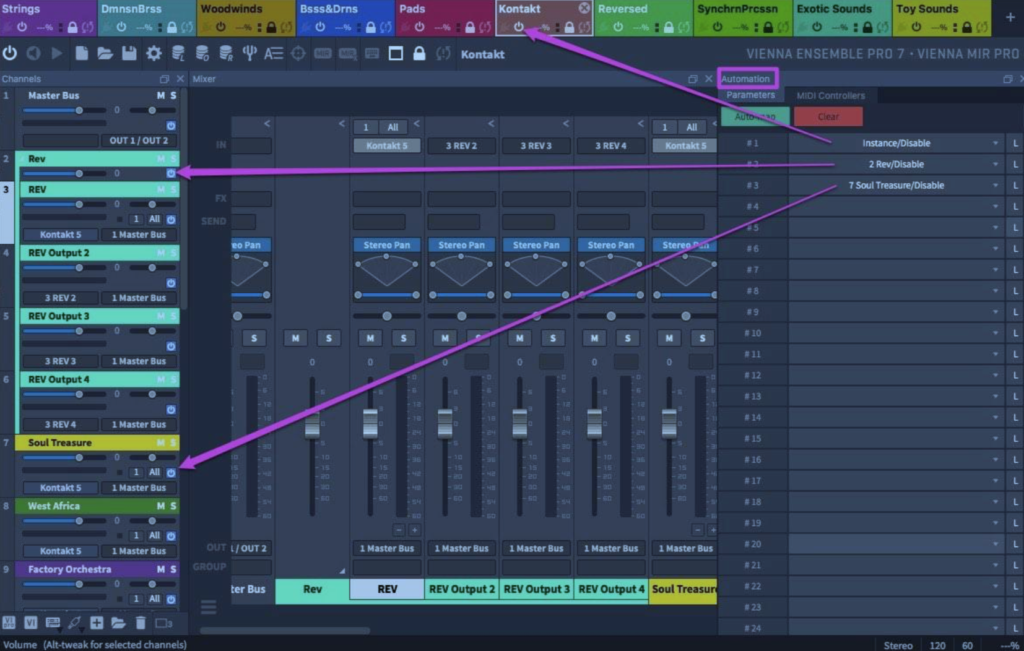
Multiple Instances could easily get out of hand quite quickly and obscure the intricacies of handling multiple musical or audio workflows. This does not happen in VEP7. Instances are easy to build, control, and work with. In version 7 they can be listed vertically in addition to horizontally as tabs. Standard Operating System colors (with the familiar Mac palette tool) can now be used in certain cases to make recognition of the components of your interface quick and more readily accessible.
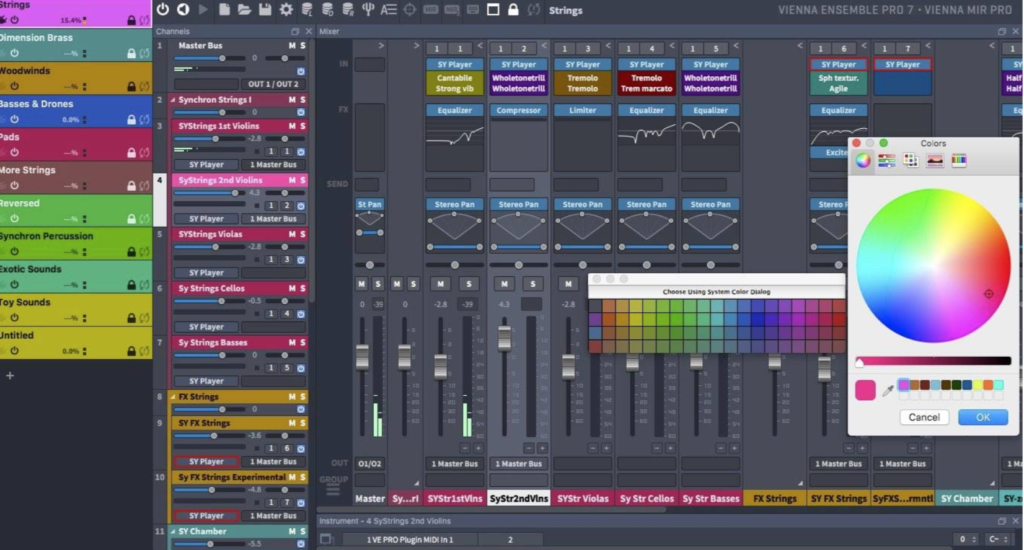
Folders and Instances can be “frozenâ€; this makes handling of project components and versions much easier. If the analogy of taming large amounts of scrolling data in a spreadsheet by freezing certain rows, columns and/or blocks of cells comes to mind, then you’re not far off: the cleaner and more selectable the elements of such a “cockpit†of controls are to the eye, the more likely your brain is to jump right to where you want to be.
VEP7 also has some improvements in the display and manipulation of Channels themselves: the current articulation now shows “inside†the channel itself whenever you’re using Vienna Synchron Player or Vienna Instruments Pro. A new red “frame†also now appears when existing patches are unavailable – again if you’re using either (or both) of those two Vienna players.
All of these improvements, of course, serve to confer on your sessions a greater sense of integration, seamlessness, and of being in charge. This represents a significant step forward for the Ensemble suite. And – given the multiplicity of ways to interconnect environments as rich as these – the developers at VSL are to be congratulated for doing a great job.
Plug-ins
Plug-ins increase and enhance control over your workflow by adding functionality to what you can do with your sounds… equalizing, compressing, limiting and analyzing – and much more.
Managing these, keeping track of how you use them and even making sense of the effects (“FXâ€) which such plug-ins have on your sound can be daunting. VEP7 has mini-viewers attached to the channels themselves into which FX plug-ins have been inserted… making the invisible audio visible again.
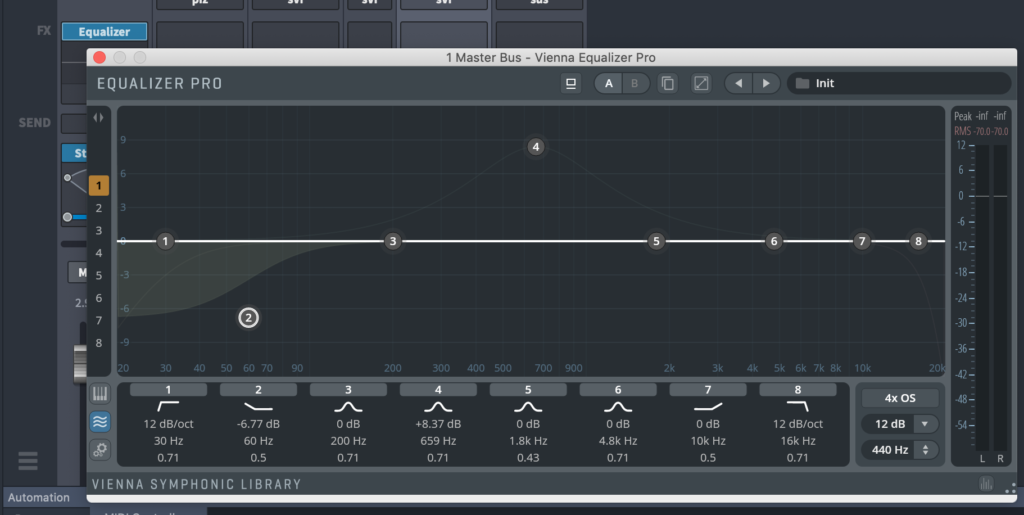
The new Favorites manager and Plugins Preferences tab allow you to create a list of your favorite plug-ins for any one project or type of work – and more easily select what you need from it. For example, if you have a series of commissions which you decide will require expansive, more reverberant sound than would be appropriate, say, for chamber music or a Lieder recital, you can now assemble “sets†of such effects without having to begin compiling – and remembering – selections from scratch.
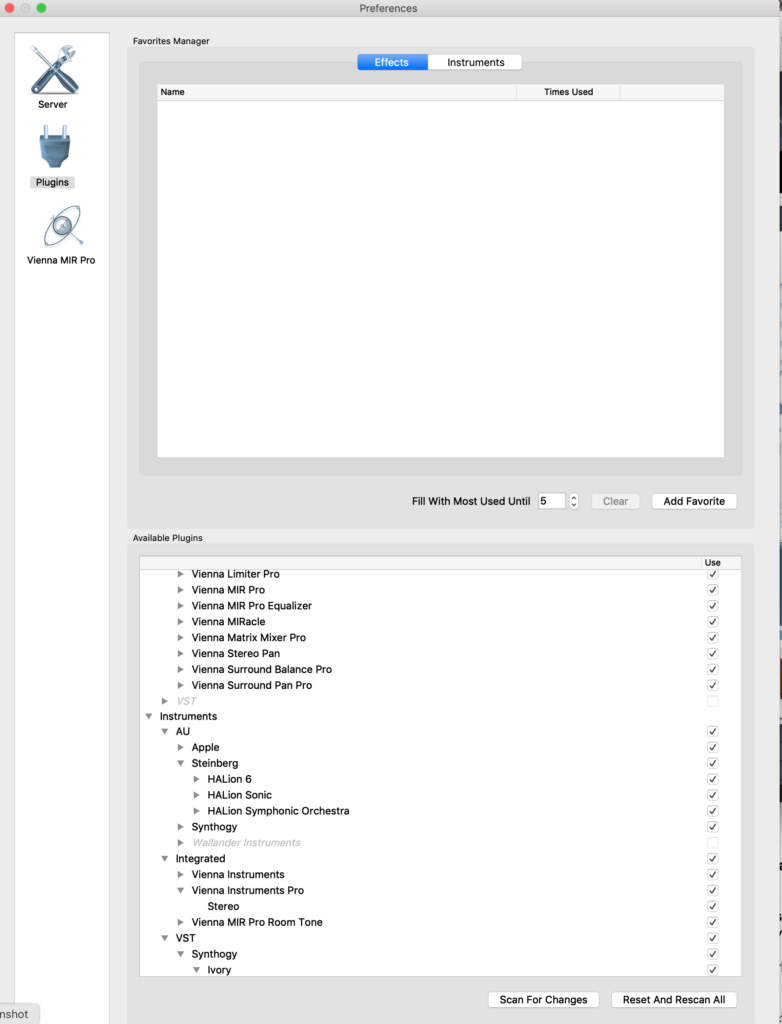
The plug-in list now sorts to display your most recently used plug-ins at the top; while the new plug-in browser allows you to search for a particular plug-in when you have more than a manageably small number of them.
Plug-ins can be tricky, they can “develop†incompatibilities, and so sometimes need your attention. VEP7 now scans and manages installed plug-ins to make this significantly easier. Sufficiently intelligent is VEP7 in this respect that it allows simple yet flexible management of all those plugins which will work in the current environment – third party as well as ‘integrated’ (VSL).
VEP7 also comes with a set of powerful plug-ins from VSL; these originated in Vienna Suite Pro: Compressor Pro, Equalizer Pro, Exciter Pro, Limiter Pro, Analyzer Pro and Pro versions of the surround-specific plug-ins, Matrix Mixer Pro, Surround Balance Pro, Surround Pan Pro. It’s hard to think of anything else that all but the most demanding user would want to achieve a huge range of effects.
With VEP7 comes a beta version of the AU3 (the Mac-only “Audio Unitâ€) plugin. Although still under development, VSL is here the first to the market with this major new advance. It supportsup to 48 MIDI Ports (that is 768 MIDI channels) per Instance. The folks at VSL are a dedicated bunch and you can be sure that feedback from users will be listened to and taken into consideration as they finalize a release version.
Workflow
It’s important that users of software like Vienna Ensemble Pro are able to concentrate on the music or audio; the intricacies of complex controls and options must not interfere. The designers and developers at VSL know this and have made several improvements in VEP7 to streamline the way you work.
More processes have been automated; and the automation is more transparent: the names of all those parameters which can be automated, and all active plug-ins, are now more clearly displayed and can be more detailed than in previous versions.
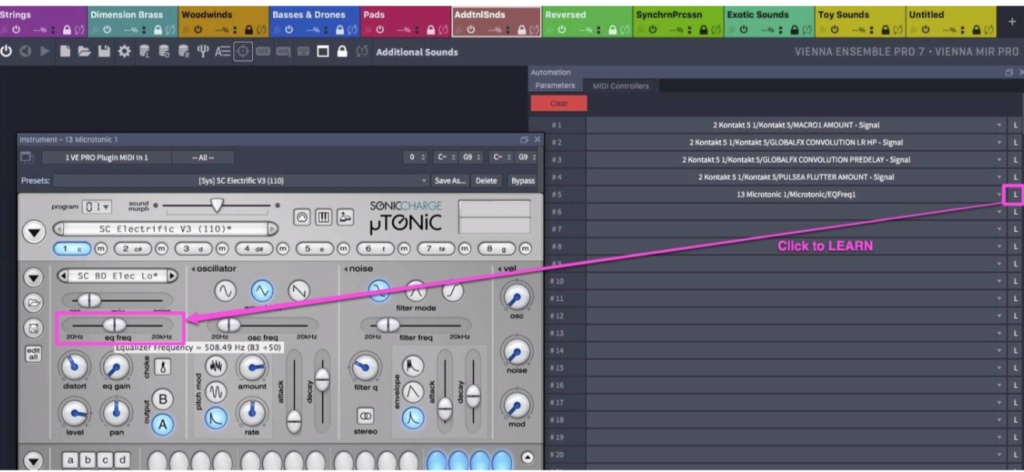
The “Learn†option allows you to reveal corresponding parameters in other applications – such as a sequencer – and hence that application’s own parameters’ names and values; then set it/them so as to automatically assign controllers in VEP7’s plugins/channels such that the resulting mapping is seamlessly preserved.
The very fact that VEP is built to work both as a standalone environment and as part of a client-server network (small or extensive) adds a layer of complexity when setting up (and managing) connectivity. VEP7 now handles server discovery and connection/disconnection of Instances more quickly and elegantly… there really are fewer puzzles for the ambitious musician to have to deal with. Saving times have also been improved in this version: Instance data is now compressed/decompressed. This will be noticed most in the case of resource-intense plug-ins like Kontakt.
In version 7 keeping track of multiple Instances has also been automated such that they can be disabled and (re-)enabled according to criteria you set up and modify.

Helpfully, all the data necessary for working with an Instance is retained (the location of samples on your particular filesystem, for example); while plug-ins and memory (RAM) are freed up from use by the selected channel(s). Given that audio software is often particularly processor-intensive, this is a significant advantage. One obvious purpose of this improvement in version 7 is to create and manipulate templates; then copy/paste selectively – Channels for example – from one project to another. There is clear visual feedback of the status of all of this on screen at all times.
Evaluation
Installation of Vienna Ensemble Pro 7 was as smooth as always – the package can either be downloaded from a link on the “MyVSL†area of the VSL site (as can the aforementioned manual); or via the Vienna Download Manager (the latest version/build is 2.2.16928, from February this year) – a model of such tools.
With Vienna Ensemble Pro 7 you also get the the Epic Orchestra 2.0 Sample Pack (priced at €105/$118) which comprises each instrument and articulation from the original Epic Orchestra – but newly enhanced, edited and mapped for the new Vienna Synchron Player and Synchron Stage Vienna; you can get a sense of just how well this all sounds here.
As remarked at the beginning of this review, the software worked impeccably in every way which was tested and evaluated. For obvious reasons, it wasn’t possible to evaluate every imaginable combination of soft- and hardware. But those which were evaluated in all cases worked just as expected. The new features left nothing to be desired.
Conclusion: VSL is a specialist company in a specialist field. Its approach is professional and efficient. Technically, their experts really do achieve some amazing results!
VSL is also always on top of its development and support… three (minor) maintenance updates were released between the time when VEP7 first became available and the appearance of this review, for instance.
Vienna Ensemble began life as a way to handle and make the most of VSL’s own virtual instrument sample sets and playback engine (Vienna Instruments). One of its chief strengths was to meet the challenges attendant on the need to distribute computing power when using audio.
Now, however, Vienna Ensemble – and version 7 in particular – has become the de facto way to do much more than that: elegantly and efficiently to manage virtually all your musical and audio resources.
Vienna Ensemble Pro 7 follows earlier versions of the software in providing the most streamlined, sophisticated and all round easiest ways to manage the complexities of audio and sound workflow in a wide range of music and audio applications.
As a product for professionals and for musicians engaged in serious music, complexity and sophistication are part of such a world. As are extensive features. Yet equally important is the need for such software to be robust and manageable.
VEP 7 is indeed robust and manageable. It achieves the balance between complexity and usability extremely well. Recommended without hesitation.
Pros: Comprehensive. Stable. Flexible. Works with multiple apps in the music and audio field. User Interface a good compromise between complexity and ease of use. Good documentation and support.
Cons: None major. Yes, the learning curve is steep. But it’s worth spending the time to get familiar with the multiplicity of things which VEP7 can do.
System requirements:
- macOS 10.10 and later (10.13 or later recommended)
- (fast separate hard drive, 7200 rpm or faster, recommended)
- at least Intel Core 2 Duo
- 2 GB RAM (4 GB recommended)
- working Gigabit connection between master and networked computer(s); also works on a one-computer setup
- ViennaKey (Vienna Symphonic Library USB protection device) or other USB eLicenser (e.g., from Steinberg or Arturia)/eLicenser Control Center software
- other configurations may work but are not actively supported; see this page and/or contact VSL for specific advice.
MyMac.com Rating: 10 out of 10

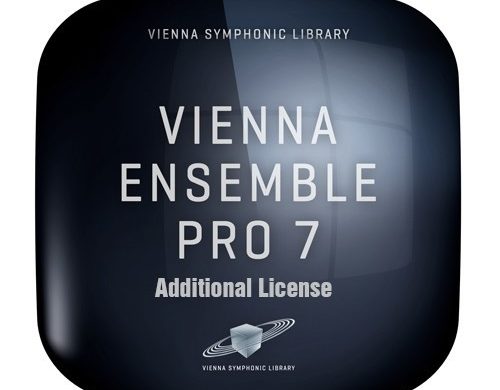
Leave a Reply
You must be logged in to post a comment.